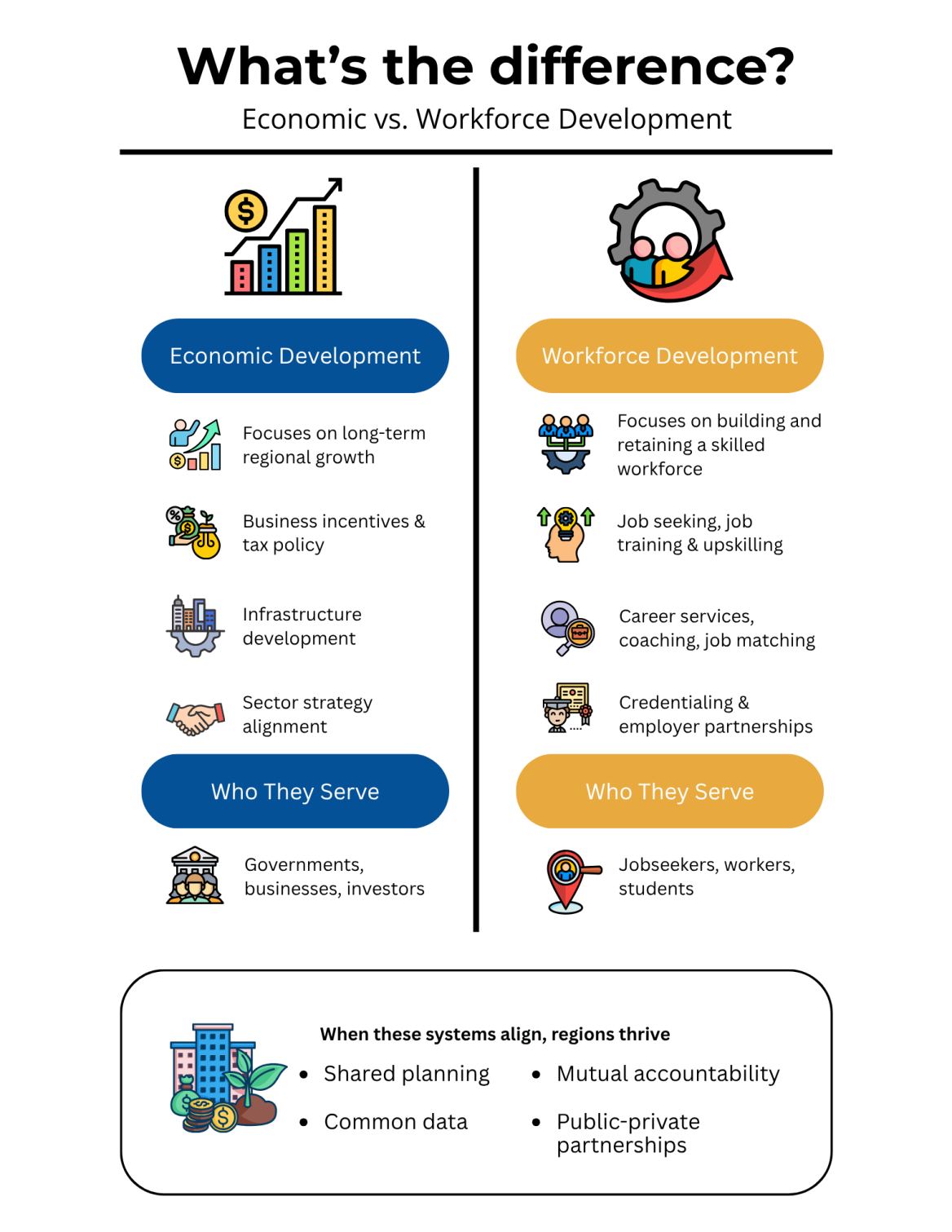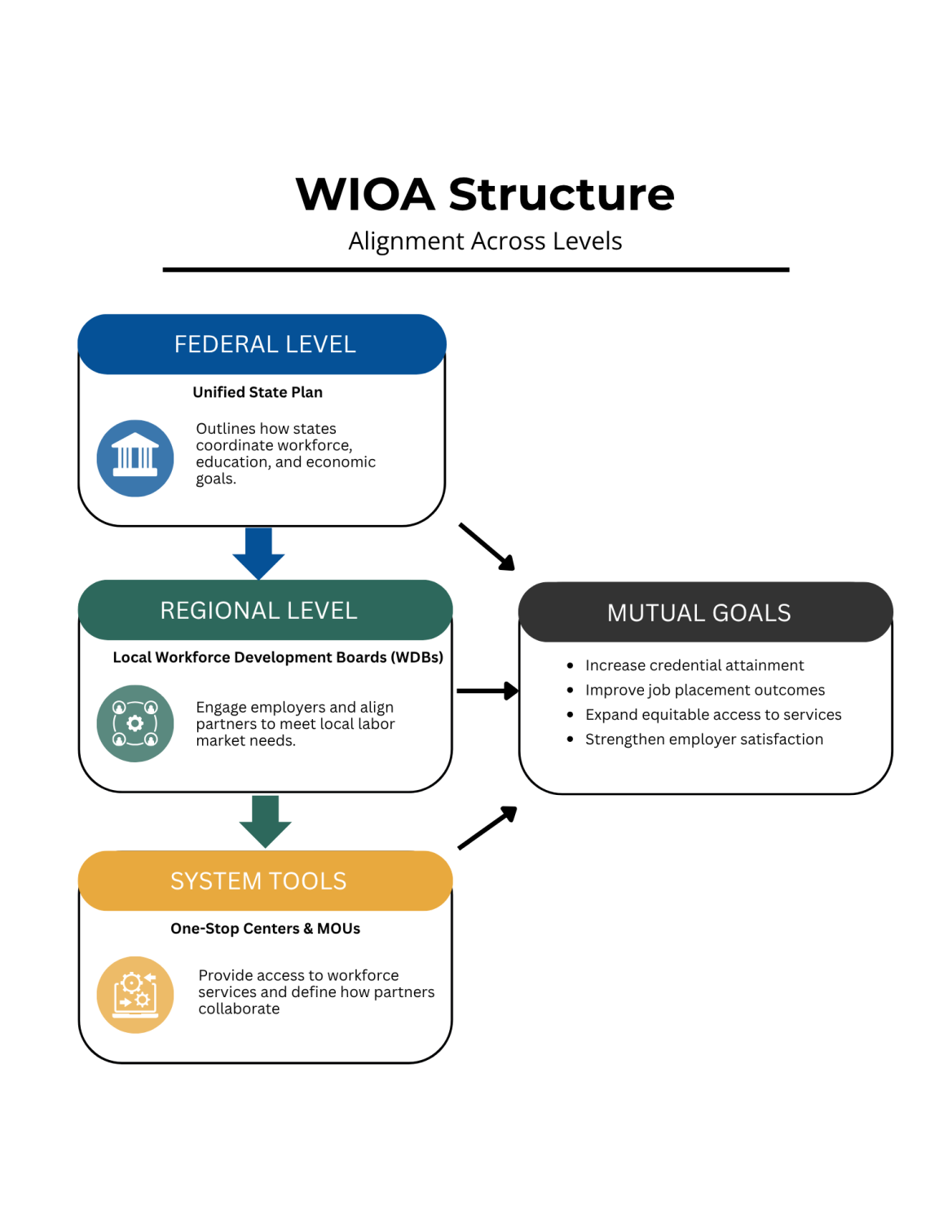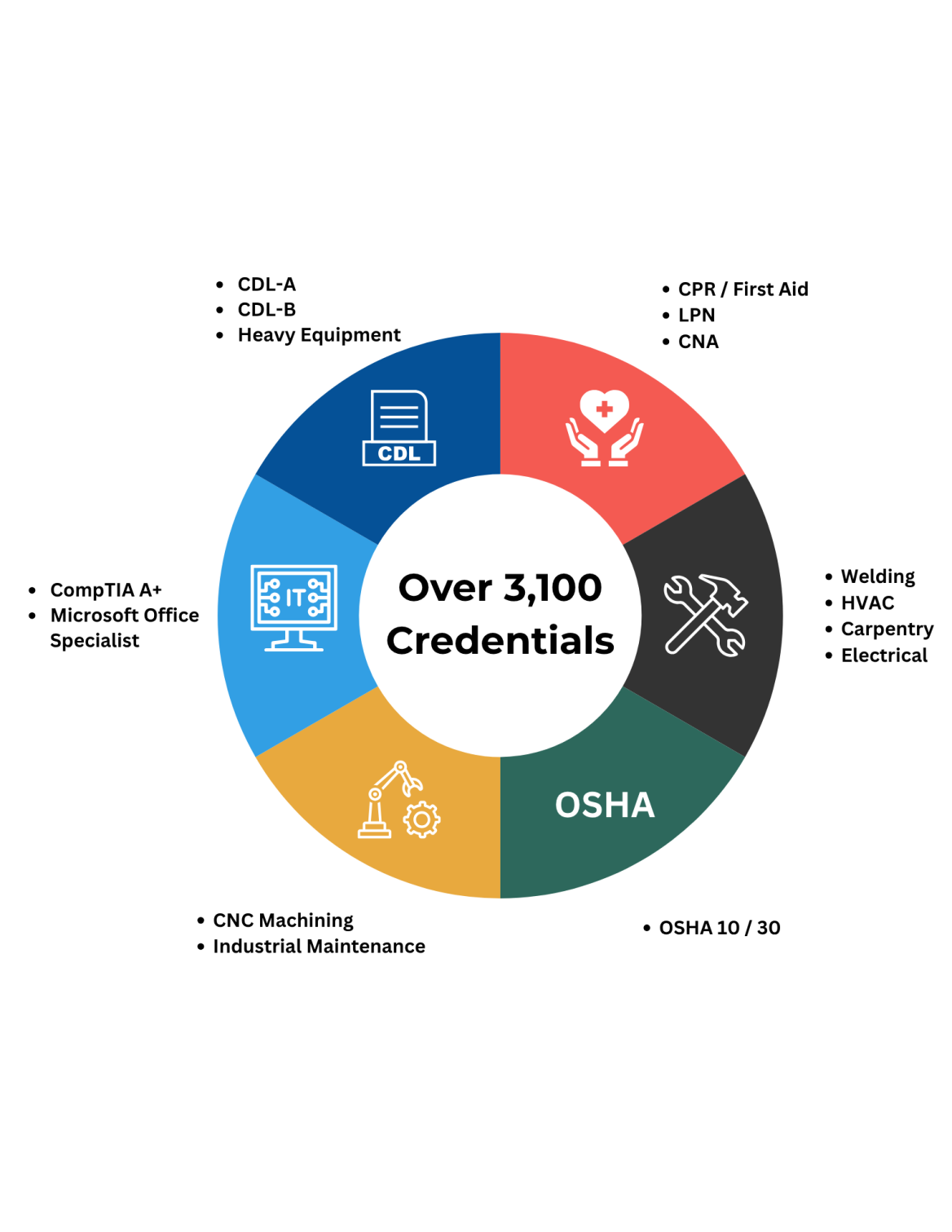Strengthening Communities Through Workforce and Economic Collaboration
This blog explores how collaboration between workforce development and economic development agencies can drive regional growth and create more resilient, inclusive communities. Anchored by the Workforce Innovation and Opportunity Act (WIOA), the article highlights practical strategies, common challenges, and real-world examples—like Pennsylvania’s Industry Partnership program—that demonstrate the power of aligning systems, data, and goals. By shifting from siloed efforts to coordinated action, regions can better meet the evolving needs of both employers and jobseekers while maximizing public investment.
If there’s one keyword to pull from the Workforce Innovation and Opportunity Act of 2014 (WIOA), it’s collaboration. WIOA doesn’t just encourage cooperation—it mandates it. States must submit unified plans outlining how workforce and economic development agencies, educational institutions, and community partners will coordinate efforts to build a more resilient labor force (Congressional Research Service, 2022). This legal framework acknowledges what seems like common sense: when employers have access to a skilled, adaptable workforce, they’re better positioned to grow, and, in turn, boost the region’s economic health. Yet despite this shared goal, true collaboration remains more of an exception than the norm. Recent studies show that even when the infrastructure for partnership exists, misaligned funding streams, siloed priorities, and short-term planning often prevent workforce and economic development agencies from fully joining forces (Sánchez & Qian, 2024; National Association of Workforce Boards [NAWB], 2024).
So, if collaboration is such an obvious win, the question remains: why haven’t these groups been working together all along?
Before discussing all of the wonderful ways workforce and economic development agencies can collaborate under WIOA, it is important to define each, as well as understand their differences.
Economic Development: The range of activities, policies, and programs of a state, a region, or a municipality used to create conditions that enable long-term economic growth.
Workforce Development: The range of activities, policies, and programs used to create, sustain, and retain a viable workforce that can support current and future business and industry. This may include education and training, job matching, and employer engagement.
Collaboration in Action: How Workforce Agencies Bring People and Solutions Together
Workforce development agencies are at their best when they serve as connectors, bringing together employers, schools, economic planners, and community groups to solve real-world problems. While the exact setup may look different in each region, the most successful efforts share a few key qualities: they’re responsive to local needs, involve shared decision-making, and focus on creating value for everyone involved (NAWB, 2024).
Across the country, workforce development has become one of the most common reasons for formal partnerships in economic development. A long-term study in Iowa found that over 57% of the state’s economic development agreements focused on workforce-related goals. Most of these involved simple, practical arrangements, like service contracts, between workforce agencies and nonprofits or community colleges (Sánchez & Qian, 2024).
These partnerships have delivered real results, such as:
- Creating regional training hubs
- Placing workforce staff in community spaces
- Coordinating critical supports like transportation or child care for jobseekers
These aren’t just pilot projects; they reflect a growing movement. Increasingly, regions are recognizing that integrating workforce solutions into broader economic strategies, especially those designed for individuals facing employment barriers, is crucial to building stronger, more inclusive communities (Congressional Research Service, 2022; NAWB, 2024).
The WIOA Framework: Turning Policy into Practice
WIOA isn’t just a funding source, it’s a blueprint for alignment. It requires states to develop unified plans that coordinate workforce, education, and economic development efforts across regions Congressional Research Service, 2022). At the local level, Workforce Development Boards (WDBs) are tasked with putting these plans into practice.
Their responsibilities include:
Convening One-Stop system partners to streamline services
Developing regional and local plans aligned with labor market data
Engaging employers directly to inform training and credentialing efforts
Setting shared performance metrics across agencies
These mandates are formalized through tools like Memoranda of Understanding (MOUs), which clarify how resources are shared and how collaboration will be sustained. The goal is to move from siloed efforts to integrated service ecosystems that make the most of public investment while expanding access for jobseekers and employers alike (Congressional Research Service, 2022). When implemented effectively, WIOA helps communities shift from fragmented program delivery to long-term regional workforce strategy (NAWB, 2024).
A study found that despite the clear benefits of aligning workforce and economic development efforts, collaboration is often limited by several persistent barriers (Meléndez et al., 2015). These include:
- Competition for funding can discourage collaboration, as organizations often view one another as rivals for limited resources.
- High initial costs, particularly in time, staffing, and relationship-building required to sustain partnerships
- Fragmented governance: the absence of a central coordinating body leads to duplicated efforts and unclear accountability.
These challenges are prevalent in regions with limited administrative capacity or where systems operate in silos. As a result, many partnerships fail to move beyond surface-level coordination.
To move forward, regions can empower workforce development boards or regional intermediaries to serve as neutral connectors, facilitating collaboration among stakeholders. These entities are well-positioned to align stakeholders through shared data, coordinated funding, and clearly defined performance goals. Supported by WIOA planning structures and formal agreements like MOUs, this approach offers a pathway from fragmented programming to integrated systems that better serve both job seekers and employers (Meléndez et al., 2015).
Suggestions for Strengthening Collaboration
Improving collaboration between workforce and economic development agencies requires more than intent. It demands structure, trust, and shared purpose. To move from parallel efforts to truly integrated strategies, regions can consider:
- Designating a coordinating entity (such as a workforce board or regional intermediary) to serve as a neutral organizer of joint initiatives and shared planning (Meléndez et al., 2015).
- Developing shared performance metrics that track outcomes across agencies, such as credential attainment, job placement, and equity benchmarks.
- Co-locating staff or cross-training frontline teams to better serve both jobseekers and employers through unified service delivery.
- Aligning employer engagement strategies by forming joint business service teams or sector-based advisory groups that include both systems.
These strategies help convert policy intent into sustainable practice, reducing duplication, building trust, and focusing everyone on what matters most: outcomes for people and businesses.
Example: Pennsylvania’s Industry Partnership (IP) Program
The Pennsylvania IP model exemplifies how workforce boards can lead economic collaboration. Each partnership is sector-focused and employer-driven, designed to meet specific labor market needs within industries like advanced manufacturing, healthcare, IT, and skilled trades.
Key elements of the IP approach include:
- Shared funding and decision-making: Employers, workforce agencies, and educators jointly determine training needs and pool resources.
- Credential alignment: More than 3,100 credentials were earned in one year alone across participating regions, from OSHA and CDL certifications to EMT and LPN-RN pathways (Pennsylvania Department of Labor & Industry, 2024.)
Shared Goals, Real Barriers
Workforce and economic development agencies share a common goal: to build thriving, resilient communities where businesses grow, and individuals succeed. WIOA provides the framework, and real-world examples like Pennsylvania’s Industry Partnerships show that collaboration is not only possible but also effective. However, as the research makes clear, good intentions are not enough; overcoming barriers such as fragmented governance and resource competition requires deliberate strategies, shared accountability, and trust built over time.
A Call to Action for Stakeholders
For external stakeholders, including funders, employers, educators, and policymakers, the message is clear. Support models that prioritize alignment empower workforce agencies as strategic leaders and invest in the infrastructure needed to transform parallel systems into unified engines for growth. Collaboration is more than a buzzword. It is the path to economic development that works for everyone.
Let’s Build Stronger Communities Together
At EDSI, we specialize in aligning workforce and economic development strategies to drive meaningful, measurable impact. Whether you're a local workforce board, funder, or community partner, we’d love to explore how we can support your goals and bring collaborative solutions to life in your region. If this work resonates with you, we invite you to connect with us using the information form below.
About the Author
Matt Giombetti has been with EDSI for over 2 years and is based in our Lackawanna County, PA office. In addition to his program role serving employers in the community, Matt supports the Marketing Team with communication initiatives and special projects. He is currently pursuing a graduate degree in Communication, bringing both academic insight and hands-on experience to his work at the intersection of workforce development and strategic communication.





